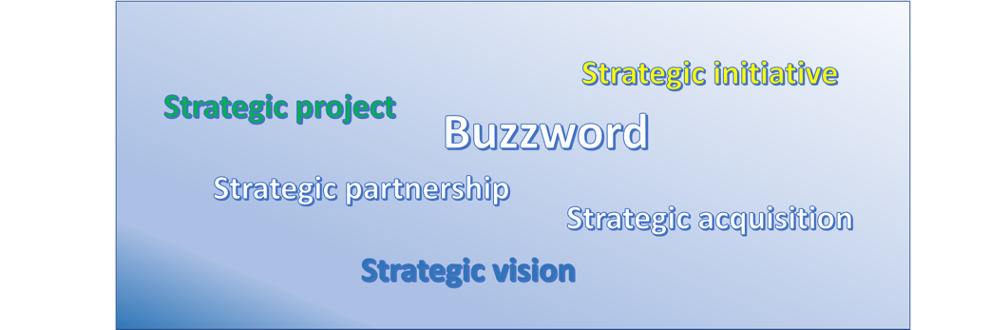Designing for superior business performance
A guide for technology, creative and startup leaders
Chapter 2 - What makes strategy difficult?
The problem is in recent years' strategy has become something of a buzzword,
whenever we want to sound smart and demonstrate our business acumen we just make
sure the word strategy shows up in our ideas.
David Kryscynki Brigham Young University
In this section
Understand the barriers to creating and executing on a complete strategy
-
Use that understanding to crush the obstacles to a complete high performance strategy.
Strategy is a relatively young concept in the business world.
For example, one of the most compelling strategy books,
Michael Porters book Competitive Advantage was published less than 40 years ago.
That may seem like a long time ago, but consider that Frederick Taylor wrote his theory of
Scientific management back around 1900. Despite being considered an "out of date"
theory since around the time Peter Drucker introduced the concepts of the new age
of the knowledge worker, many scientific management practices still dominate
organizational thinking today. Change takes time, and original messages get
lost.
Lack of understanding

Strategy as a buzzword used to decorate or make standard concepts sound more important
Strategy has for a variety of reasons become something of a buzzword.
Once the word is used in so many varied usage scenarios it
becomes difficult to understand the purpose or role of strategy in a business.
A benefit from this guide and using the StrategyCAD platform is it defines
what a complete strategy is and provides the recipe and guidance to
create and then do one. It eliminates
strategic fluff on focuses resources on the important stuff (-:
Confusing implementation time with strategy
Strategy is also often confused with implementation time. It is anecdotally common to see people consider an initiative that takes 1, 2 or 3 years as strategic. In contrast, short-term 1, 2, 3-month activities are seen as tactical. Strategy, however, is unrelated to implementation time. Strategy is about making an integrated set of mutually supportive choices for optimizing how the aspirations related to business performance are achieved. Strategy is not something that happens sometime in the future, it ideally starts happening today and is continuously occurring. If we say that strategy is the design for superior business performance, the question is, why would resources be allocated to anything else?
Strategy takes courage
Strategy requires you to make decisions purposed to produce outcomes outside your direct control. These are not routine day-to-day activity decisions, but significant decisions affecting resource allocations and business performance subject to uncertainty. For example, we will invest in product A focused on market B at the expense of product C in another market D. It takes courage to make these types of decisions. What if we are wrong? Consequently, many leaders and leadership teams avoid making these types of decisions. Instead, these teams try to do a bit and often too much of everything. Resources are spread too thinly, often failing to achieve any superior or valuable outcome in any area and mediocrity or failure in the others. The leadership then laments the failure to execute, but in reality, the failure was in making choices to focussing the capability and resources on what would offer the best possible return. Setting high performance expectations and then making the decisions necessary to achieve them takes courage and a willingness to test the assumptions in those decisions and learn whether those decisions are right or wrong.
Courage to break with conformity
One additional courage aspect of business strategy is about choosing to be different. If we want superior performance, we may not be able to do what we have always done, nor what everyone else is doing. Conformity, nonetheless, is a powerful motivator and hence choosing to be different takes courage. Doing what everyone else is doing provides the comfort of the herd mentality. If everyone is doing X then it must be right, we should do that too. Strategy will often involve not doing what everyone else is doing but following a reasonable theory of what a market needs which in return offers return of business value. The value proposition section will highlight differentiation choices.
Productivity prioritized over creativity

96% of business leaders reported lacking time to think strategically
Strategy is both a creative and scientific activity. It is creative in that it is designing a high-quality value proposition that in turn creates a high-performance business. It requires a scientific approach of assessment, analysis, decisions, action, and evaluation. Indeed, according to Management research group survey of 10,000 leaders 97% acknowledged that strategic thinking was the key to longer term success, but 96% acknowledged they lacked sufficient time for strategic thinking.
Strategy as a creative design process is fuelled by curiosity. A good strategist, like a creative child, asks a lot of questions, asks for clarification on a lot of assumptions, and historical decisions. They do this over and over switching between understanding external events, industry events and internal situations until clarity is accomplished, constraints revealed and opportunities discovered. This can be difficult in many business environments where everything is seemingly urgent and time-bound. Consequently, good insight driven strategy becomes difficult. It is just too tempting to skip all that thinking, questioning, investigating and analysis and instead go straight to action.
Lack of methodology
In the absence of a viable recipe to create a strategy, strategy
creation can take up more time that anyone has and then not deliver the
benefits anticipated from that time. Hence, many leadership teams will
prefer to just get on with it, whatever it is.
It will often take some significant (Kodak, Blockbuster moment)
event that seriously undermines the viability of business performance
for these types of leadership teams to embrace a complete methodology for
business strategy.
StrategyCAD™provides extensive guidance on the steps / recipe to create
a complete strategy along with detailed thinking guidance on related decisions
including which markets, industry segments, customer segments, products,
offerings, distribution channels, costs management and more
Non-sensible Strategy Negating Mantras
There are ridiculous quotes that are uttered far too frequently that undermine the value of strategy. Some of these include:
Culture eats strategy for breakfast Attributed to the great Peter Drucker. It is the classic scarcity type thinking, that implies you can have strategy or culture. Why not create a great strategy and culture. There is nothing to indicate these are mutually exclusive. Indeed, a good strategy enables the way people work. Strategy contributes to culture. The absence of sustainable strategy will see the death of any great culture. Blockbuster had a fun in store culture but lacked a sustainable strategy.
Bad strategy well executed is better than a good strategy not executed This is of again engages the scarcity or limited thinkin assuming you can only have one unsatisfactory option or another. Why not have a good strategy and have it well executed?
A little thought can save a lot of wasted effort.
The perception of needing a business degree
There is a reason why many of the top business leaders today have technical
backgrounds. Strategy is a creative design process. It is performance design
of a business, and the components (as you will see later) are defined as are the
relationships between them.
A business degree offers some advantage for financial modelling and financial
management for strategy validation and implementation.
However, many people with business degrees lack skills in strategy to
match their accounting or finance skills.
Strategy in terms of its’ purpose, methodology can be learned by anyone.
Many successful business leaders have never been to business school.
Strategy is a creative process driven by the desire to serve,
create value, make an impact, and then engineer the value chain to enable the
delivery of that value.
A business degree offers no substantial advantage to do that.
Given the close relationship of Strategy with architecture and design,
creativity then technically minded people may be more accustomed
to dealing with the ambiguities and engineering methods supportive
of business strategy.
Challenge for you
What do you see as the most significant challenge to designing an approach to increase business performance in your business?
How could you overcome these barriers?

The StrategyCAD platform guides you and your team through a huge variety of potential choices and decisions to design, deliver and sustain your value proposition. You can try it as part of this guide for 30 days free. After that if you are not convinced your team has more clarity, focus and seeing superior satisfaction and performance you can cancel at any time.